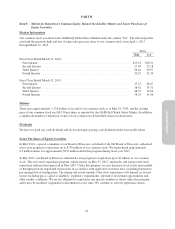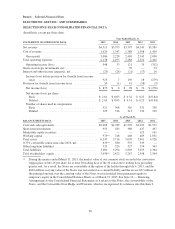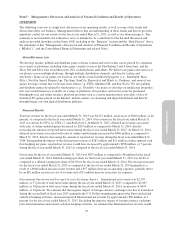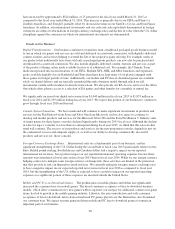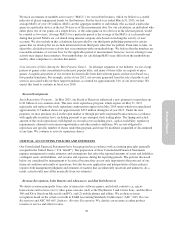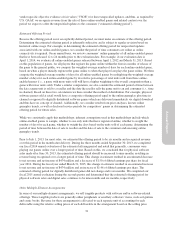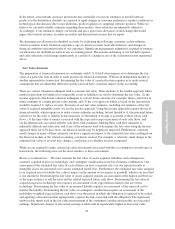Electronic Arts 2015 Annual Report Download - page 102
Download and view the complete annual report
Please find page 102 of the 2015 Electronic Arts annual report below. You can navigate through the pages in the report by either clicking on the pages listed below, or by using the keyword search tool below to find specific information within the annual report.hierarchy described below. If the arrangement contains more than one software deliverable, the arrangement
consideration is allocated to the software deliverables as a group and then allocated to each software deliverable
in accordance with ASC 985-605.
We determine the selling price for a tangible product deliverable based on the following selling price hierarchy:
VSOE (i.e., the price we charge when the tangible product is sold separately) if available, third-party evidence
(“TPE”) of fair value (i.e., the price charged by others for similar tangible products) if VSOE is not available, or
our best estimate of selling price (“BESP”) if neither VSOE nor TPE is available. Determining the BESP is a
subjective process that is based on multiple factors including, but not limited to, recent selling prices and related
discounts, market conditions, customer classes, sales channels and other factors. In accordance with ASC 605,
provided the other three revenue recognition criteria other than delivery have been met, we recognize revenue
upon delivery to the customer as we have no further obligations.
We must make assumptions and judgments in order to (1) determine whether and when each element is
delivered, (2) determine whether VSOE exists for each undelivered element, and (3) allocate the total price
among the various elements, as applicable. Changes to any of these assumptions and judgments, or changes to
the elements in the arrangement, could cause a material increase or decrease in the amount of revenue that we
report in a particular period.
Principal Agent Considerations
In accordance with ASC 605-45, Revenue Recognition: Principal Agent Considerations, we evaluate sales of our
interactive software games via third party storefronts, including digital storefronts such as Xbox Live
Marketplace, Sony PSN, Apple App Store, and Google Play, in order to determine whether or not we are acting
as the principal or as an agent, which we consider in determining if revenue should be reported gross or net of
fees retained by the storefront. Key indicators that we evaluate in determining gross versus net treatment include
but are not limited to the following:
• The party responsible for delivery/fulfillment of the product or service to the end consumer
• The party responsible for the billing, collection of fees and refunds to the consumer
• The storefront and Terms of Sale that govern the consumer’s purchase of the product or service
• The party that sets the pricing with the consumer and has credit risk
Based on the evaluation of the above indicators, we have determined that we are generally acting as an agent and
are not considered the primary obligor to consumers for our interactive software games distributed through third
party digital storefronts. We therefore recognize revenue related to these arrangements on a net basis.
Sales Returns and Allowances and Bad Debt Reserves
We reduce revenue primarily for estimated future returns and price protection which may occur with our
distributors and retailers (“channel partners”). Price protection represents our practice to provide our channel
partners with a credit allowance to lower their wholesale price on a particular product in the channel. The amount
of the price protection is generally the difference between the old wholesale price and the new reduced wholesale
price. In certain countries for our PC and console packaged goods software products, we also have a practice of
allowing channel partners to return older software products in the channel in exchange for a credit allowance. As
a general practice, we do not give cash refunds.
When evaluating the adequacy of sales returns and price protection allowances, we analyze the following:
historical credit allowances, current sell-through of our channel partners’ inventory of our software products,
current trends in retail and the video game industry, changes in customer demand, acceptance of our software
products, and other related factors. In addition, we monitor the volume of sales to our channel partners and their
inventories, as substantial overstocking in the distribution channel could result in high returns or higher price
protection in subsequent periods.
32



